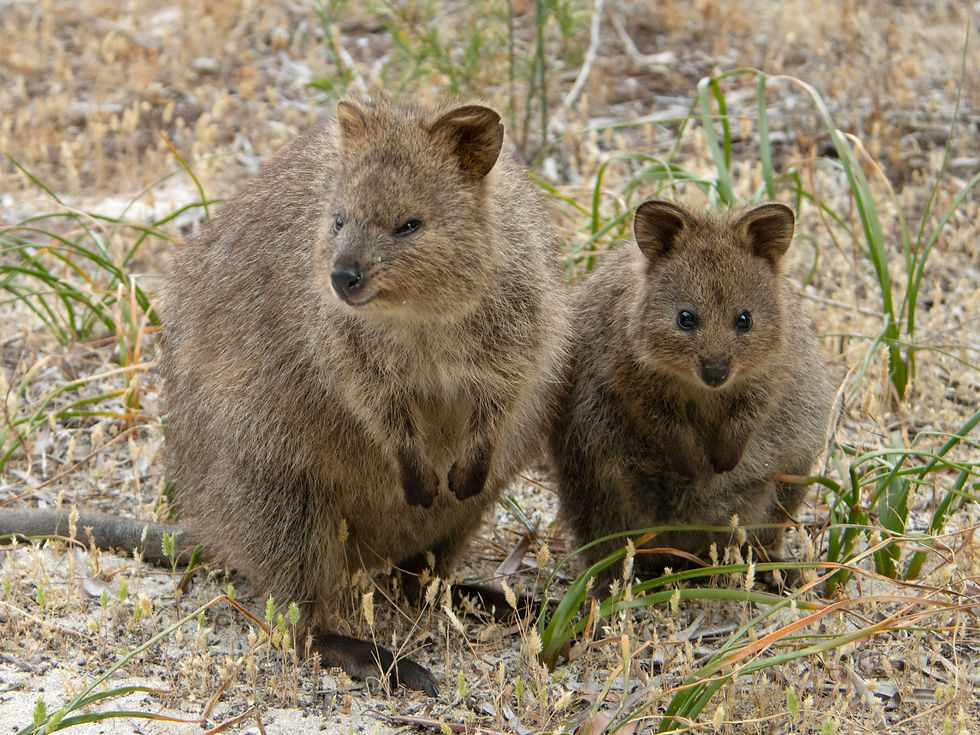Did you know: The Quokka - Australia’s Smiling Marsupial 🎥
- Inga

- Aug 15
- 3 min read
If you've ever seen a photo of a quokka, you might have noticed their charming smile. These small marsupials are often called "the world's happiest animal" because of their friendly faces and curious behavior. Native only to a small region of Australia, quokkas have become a beloved symbol of wildlife and conservation.

What is a Quokka?
A quokka (scientific name Setonix brachyurus) is a small marsupial about the size of a domestic cat. They have thick, coarse grey-brown fur, rounded ears, a short tail, and a broad face with a naked nose. At first glance, the early Dutch explorers in the 1600s mistook them for large rats, which is how 'Rottnest Island' got its name ("Rotte nest" meaning "rat's nest"). But quokkas are far from rats—they are actually relatives of kangaroos and wallabies, and like them, quokkas hop around on strong back legs.
Female quokkas have pouches where they carry their young, called joeys. The joeys stay in their mothers’ pouches for about 6-7 months before venturing out. Quokkas reach maturity after about 1.5 to 2 years and can live up to 10 years in the wild.
Where Do Quokkas Live?
Today, quokkas are found mostly on Rottnest Island, a small island off the coast of Western Australia near Perth, where an estimated 10,000 quokkas live. They are also found on Bald Island near Albany and in some small mainland areas in the southwest forests of Western Australia.
Quokkas prefer dense vegetation areas such as shrublands, forests with plenty of undergrowth, and places near water sources. They enjoy warm climates but can adapt to seasonal changes. On the mainland, quokka populations have dwindled substantially over the past century due to various threats, but Rottnest Island remains their safe haven.
Quokka Behavior and Diet
Quokkas are primarily nocturnal, which means they are most active during the night. However, on Rottnest Island where predators are almost absent and humans often feed them, they can be seen during the day. They are herbivores and eat a variety of native plants, grasses, leaves, and even the needles of the Norfolk pine.
One interesting fact is that quokkas rarely drink water—they get most of the moisture they need from their food. They have adapted to live in their environment with limited water availability.
Conservation Status and Threats
Quokkas are currently listed as vulnerable by the International Union for Conservation of Nature (IUCN). This means they are not extinct but face a high risk of becoming endangered if threats continue. The main dangers to quokkas include habitat loss, predation by introduced species such as foxes and feral cats, bushfires, and climate change.
Bushfires in particular are a serious threat. Quokkas rely on dense vegetation for shelter and food, and intense fires can destroy their habitat. Recovery after a serious fire can take a long time because quokka populations grow slowly.
Encouragingly, researchers made an exciting discovery in late 2024 when they found a previously unknown quokka population in the Perth Hills. This finding offers new hope for the species' recovery and demonstrates that conservation efforts and habitat protection can help these vulnerable marsupials survive in unexpected places.
Conservation efforts focus on protecting the quokkas' natural habitats and controlling predators. On Rottnest Island, where there are no foxes or feral cats, quokkas thrive, which highlights the importance of predator-free zones for their survival.

Why Are Quokkas So Popular?
Quokkas have become famous worldwide mainly because of their curious and friendly nature. Unlike many wild animals, quokkas seem to be unafraid of humans and often approach people, especially on Rottnest Island. Tourists love to take "quokka selfies" and see these little creatures up close.
Their “smiling” appearance has won the hearts of many. Although the quokka’s smile is just a natural facial structure, it looks like they are always happy, which adds to their charm.
How to Help Protect Quokkas
If you're lucky enough to visit quokka habitats, especially Rottnest Island, it’s important to look after these special creatures responsibly:
Do not feed quokkas human food, as it can harm them.
Keep a respectful distance and avoid touching them.
Stick to walkways and follow local guidelines to protect their natural environment.
Support conservation programs and wildlife organizations working to protect quokkas and their habitats.
Quokkas are a wonderful example of Australia’s unique wildlife. Their survival depends on our continued care and respect for the environment they live in. Seeing a quokka in the wild is truly a special experience, one that reminds us of the beauty and fragility of nature.
🎥 (0:38) Quokka - Happiest Animal (Remarkable Animals video)
🦘
More “Did you know” series reading:







Comments